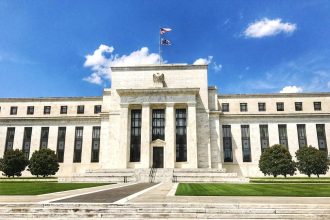Consumers have weathered an economic storm unlike any in recent memory, as the Federal Reserve rushed to slow the economy down from an overheated post-pandemic boom. The tide, however, could be turning.
The Federal Open Market Committee (FOMC) voted to leave interest rates at a 23-year high of 5.25-5.5 percent when it wrapped up its July meeting but opened the door to eventually cutting interest rates. Investors and economists continue to expect that the first rate cut since the early days of the coronavirus outbreak in 2020 could be in the cards as soon as the Fed’s next gathering in September.
The Fed sets a key benchmark interest rate that has a domino effect on virtually every borrowing cost that consumers pay — from credit cards to auto loans, as well as adjustable-rate mortgages and personal loans. Rates tend to move in lockstep, meaning cuts from the Fed will ultimately make it cheaper to borrow money.
The ultimate question is how much financing costs could fall. Chair Jerome Powell has indicated that officials don’t want to let up on the brakes too fast, for fear that it could exacerbate inflation. U.S. central bankers, however, also don’t want to keep borrowing costs too high for too long, in fear that it might unnecessarily slow down the economy and the job market.
Financing costs are likely to remain historically elevated, unless a major economic slowdown prompts the Fed to cut interest rates aggressively. Yet, any turning point in Fed policy means it’s a good time to revisit your financial strategy.
Here’s your 12-step plan for taking charge of your wallet as the Fed gets ready to cut interest rates.
Interest rates took the elevator going up but are going to take the stairs coming down.
— Greg McBride, CFA | Bankrate chief financial analyst
1. Get a snapshot of your personal finances
Before the Fed cuts interest rates, consumers should get an idea of their current financial state, including how much debt and savings they have. Once you form a baseline understanding, you’ll be better informed about your financial strengths — and your potential weak spots.
Print out statements from any account housing liquid cash — or money you could withdraw without penalty. Those are most likely savings accounts, but they could also be funds in a money market account or no-penalty CD. Even better, note each account’s annual percentage yield (APY).
Next, list your debt, including your outstanding balance and the interest rate you’re charged. Keep tabs on whether that debt has a fixed or variable rate, and note how much interest you pay per month.
Then, keep track of the income and expenses flowing in and out of your budget each month.
2. Keep chipping away at high-interest rate debt
Even with lower interest rates on the horizon, one piece of advice stays the same: Prioritize eliminating your high-interest rate debt.
High-cost debt commonly comes from a credit card. Even when the Fed’s rate held near zero while the economy recovered from the pandemic, the average credit card rate hovered around 16 percent, according to Bankrate data. If you don’t pay off your balance in full each billing cycle, that’s likely costing you hundreds — if not thousands — of extra dollars a month. Today, they’re holding near 21 percent.
“The Fed’s going to have to cut rates a whole bunch of times before your rate gets below 21 percent,” McBride says. “Interest rates aren’t going to fall far enough, fast enough to bail you out of a bad situation.”
Consider consolidating your outstanding balance with a balance-transfer card. Most cards start borrowers with a rate as low as zero percent for a specified number of months — currently a maximum of 21 months — before transitioning to the regular annual percentage rate (APR). The economy’s resilience is also good for borrowers with credit card debt: Issuers are less inclined to take those consolidation offers off the market.
The same advice doesn’t apply to those with fixed-rate debts such as mortgages or car loans with “low and mid-to-single-digit rates,” McBride says. You might be better off putting that money toward other avenues that meet your financial goals, such as saving or investing.
3. Shop around for the most competitive borrowing rates
Shopping around will be one of the most important steps a consumer can take once lower interest rates are on the horizon.
Mortgage rates, for instance, have already been edging lower as rate cuts come further into view. The key 30-year fixed-rate mortgage fell to 6.9 percent after 22 consecutive weeks above 7 percent, Bankrate’s rate data shows.
Other loans that directly track the federal funds rate — such as home equity loans and home equity lines of credit (HELOCs), adjustable-rate mortgages, credit cards, car loans and more — could begin to fall in the immediate weeks after the Fed cuts interest rates.
Some lenders, meanwhile, might be even more inclined to offer better deals than others to lure new customers. Financial experts typically recommend comparing offers from at least three lenders before locking in a loan.
Keep in mind, however, that Americans with fixed-rate debts won’t feel any impact when the Fed adjusts borrowing costs. Those with variable-rate debts could see their interest rate change within one-to-two billing cycles.
4. Watch out for the right time to refinance
One benefit to reconfirming the interest rates you’re paying if you do have debt: You’ll be more informed to act quickly if a window to refinance suddenly opens.
Sometimes, though, those decisions come down to more than just finance. Refinancing a longer-dated debt such as a fixed-rate mortgage might also depend on how long you plan to stay in your home, according to McBride.
“If you can reduce your fixed mortgage rate by one-half to three-quarters of a percentage point, it is time to do the math on how quickly the monthly savings will recoup the costs of refinancing,” he says. “If you’re planning on moving in the next 3 to 5 years, it probably won’t be worth it.”
Should you refinance this year?
With rates set to fall, does it make sense to refinance this year?
Learn more
Meanwhile, there’s not as much urgency to refinance variable-rate loans when interest rates are falling — “unless you can shave a couple of percentage points in rate by doing so,” McBride says. Just be sure to calculate the fees and new monthly payment to determine whether the change is worth it.
5. Work on boosting your credit score
If there’s any factor that inhibits consumers’ ability to borrow cheaply more than the Fed, it’s their personal credit scores. Most of the time, financial companies save the best rate for the so-called “safest” borrowers: those with good-to-excellent credit scores and a reliable credit profile.
Companies even tend to grow pickier about who they approve for loans when rates are high. Half of applicants have been rejected for a loan or financial product since the Fed started raising interest rates, a Bankrate survey from March found. Rejection rates were highest for individuals with credit scores below 670.
To improve your credit score, concentrate on making all of your debt payments on time and keeping your credit utilization ratio as low as possible — the two factors with the biggest influence on how your rating is calculated.
6. Think twice about big-ticket purchases, but you can’t always time the market
How much the Fed cuts interest rates depends on the broader U.S. economy, including how quickly inflation is slowing and whether unemployment is rising.
Consumers who can afford to wait might benefit from holding off on any big-ticket purchases that require financing.
Even modest rate reductions can translate to major savings. For instance, financing $500,000 on a 30-year fixed-rate mortgage at 6 percent would come with a monthly principal and interest payment that’s 9 percent cheaper than where it would be today, with rates currently at 6.9 percent, Bankrate’s mortgage calculator shows.
Investors are currently projecting that the Fed will cut interest rates by 75 basis points this year, according to CME Group’s FedWatch tool. That would only take borrowing costs back to levels last seen in February 2023.
To be sure, consumers can’t always successfully time the market. A car can break down or a roof can need repairing regardless of the rate environment.
“If your dishwasher breaks and you need a new one but it means financing it, are you going to wash the dishes by hand in the next six months in hopes that you can finance it at a lower rate at the end of the year?” McBride says. “Rates aren’t going to come down fast enough or soon enough to validate that decision.”
7. Keep up frequent communication with your credit card issuers
Issuers might also be inclined to give you a new APR if your credit score improves, says Bruce McClary, spokesperson for the National Foundation for Credit Counseling.
It leads to another crucial step in your financial plan: opening up the channels of communication with your credit card issuer.
“It’s sad how few people talk to their creditors when times are good because it’s when you have those conversations, you realize a lot of really great things you could be doing to save even more money,” he says.
In today’s high-rate environment, it’s worth reviewing your cardholder agreement and making sure you know how your issuer calculates your APR. Credit card companies, by law, have to give cardholders a 45-day notice if they’re going to increase their cardholder’s interest rate.
“Credit card companies do have some latitude in deciding when and how much to increase a cardholder’s interest rates within the confines and constraints of the Card Act,” McClary says. “It’s in those areas that the details are going to be in the cardholder agreement.”
8. The good times will keep on rolling for savers, even if the Fed cuts interest rates
Yields on savings accounts and CDs will edge lower once the Fed starts cutting interest rates, but that shouldn’t disappoint savers too much. What’s most important for savers is whether the cash they’re keeping on the sidelines is growing faster than the overall rate of inflation.
The 10 best high-yield online banks ranked for July 2024 are currently offering an average yield of 5.1 percent, nearly nine times the national average and 500 times higher than yields at Chase and Bank of America. Those banks offer yields as high as 5.3 percent and as low as 5 percent. The market’s top-yielding online bank, meanwhile, is paying a 5.55 percent APY, Bankrate data shows.
That compares with an annual inflation rate of 3 percent, according to the latest data from the Bureau of Labor Statistics’ consumer price index (CPI).
Typically, online banks can reward their depositors with higher yields because they don’t have to pay the overhead associated with operating a brick-and-mortar financial institution.
But saving money isn’t just about yield-chasing. A crucial part of any financial plan is having cash for emergencies. Experts typically recommend storing six months’ worth of expenses in a liquid and accessible account. Even if you can’t afford to stash that much away, any little bit can help protect you from accruing high-cost credit card debt when an unexpected expense pops up.
“Building a rainy day fund is really important, even if the interest rate you’re earning on those funds is lower than the inflation rate,” says Mike Schenk, deputy chief advocacy officer at the Credit Union National Association. “Put a little bit into a savings account over time, and before you know it, you’ll have a chunk of savings that can give you a better night’s sleep at the very least.”
9. If you already have an emergency fund, now’s the time to lock in a long-term CD
The mere expectation of the Fed reducing rates in the near-future can send yields tumbling. Case in point: The highest-yield 2-year CDs are offering consumers an APY of 4.81 percent, and the top 5-year CDs are offering 4.5 percent. Both have already edged lower, peaking at 5.75 percent and 4.85 percent, respectively.
If you already have at least six to nine months’ worth of expenses stashed away in a savings account and don’t mind locking away your cash, a CD might be a strong — and safe — way to add some yield to your portfolio of investments, including for retirees. There’s no monetary benefit to waiting to lock one in, McBride says.
“Now is the time to lock in high-yielding CDs,” McBride says. “There is no advantage to waiting, as yields will trend lower as we get closer to the first Fed rate cut and accelerate further the longer you wait.”
10. Start recession-proofing your finances
The odds of the Fed slowing inflation without causing a recession look brighter than they did in 2022, but it’s still wise to prepare for the unexpected. Monetary policy is positioned to keep weighing on economic growth, even as the Fed starts dialing back interest rates. Another concern is that the Fed may be waiting too long to cut interest rates, as unemployment rapidly increases.
“Raising interest rates is putting the brakes on the economy,” McBride says. “The cumulative impact of ongoing rate hikes is where you’re likely to see a slowdown in economic activity and the labor market.”
Recessions aren’t always as severe as the coronavirus pandemic, the Great Recession or even the Great Depression almost a century ago. They do, however, mean increased joblessness, reduced hiring or job security, as well as market volatility.
That means it’s important to start thinking about how you’d stay afloat in a recession. No matter how strong the U.S. economy is, it’s always important to live within your means, chip away at your debts and make sure you can cover a period of joblessness.
11. Think about your career and income opportunities
When the cost of living rises or the economic outlook seems shaky, one of the best investments you can make is in yourself. Think about ways to increase your earnings opportunities over your lifetime, whether by getting more training, education or increasing your skills. Joblessness is typically lower for those with a bachelor’s degree or higher — even during recessions, according to data from the Labor Department.
“You have to be looking down the road because what’s far more impactful to household finances than an increase in interest rates is a job loss or a significant decline in wealth,” McBride says. “Those are the types of things that happen in a recession.”
12. Tune out market volatility if you’re investing for the long term
High rates typically cause market dysfunction. In 2022, for example, the S&P 500 plunged roughly 20 percent, the worst year for the major stock index since 2008.
Financial markets haven’t been as downtrodden in 2024, but the optimism might not last forever. The Fed could disappoint markets by refusing to cut interest rates as much as investors are currently expecting. A slowdown, on the other hand, might make investors fearful about economic growth and companies’ continued profit growth.
But it shouldn’t mean anything for long-term investors, especially those who are saving for retirement. If you’re investing over a time horizon that spans decades, you’ll no doubt have to endure both booms and busts. Downdrafts in the market are also a powerful buying opportunity. Investing comes with risks, but it’s historically the best way to beat inflation over time.
“Keep on keeping on with your retirement contributions,” McBride says. “Ten years from now, you’ll be glad you did.”
Read the full article here














